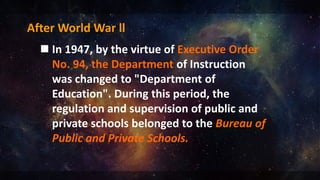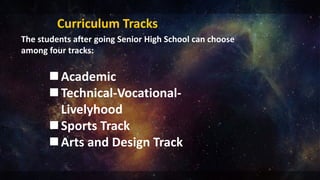EDUC-7 SUMMER CLASS
- 3. Development of Education In the Philippines from Pre-Hispanic to Present Time
- 4. No formal schools Learning began at home Oral, practical hands on The objectives was basically to promote reverence for, and adoration of Bathala respect for laws, customs, and authorities represented by parents and elders. Pre-Hispanic And Pre-Spanish Period Education
- 5. Education During the Spanish Regime Friars established parochial schools linked with churches to teach catechism to the natives. Religion was a compulsory subject at all levels.
- 6. Education was privileged to Spanish students. 19th Century - public education for the natives. Educational Decree of 1863 -required the establishment of one primary school for girls and one for boy in each major town of the country. Establishment of the normal school for training of teachers. Spanish Language - medium of instruction in all schools.
- 7. Philippine Revolution Illustrados - spread headed the Propaganda movement. Curricular Reforms. 1. Secularization of education. 2. Instructions of Spanish. 3. Greater attention to natural science. 4. The design of a relevant curriculum. 5. Improvement of higher center of learning. 6. Improvement of educational system.
- 8. Education Priority during the Malolos Republic. August 29, 1898 Schools were re-opened by the Secretary of the Interior. Established: Free and compulsory primary education. Secondary of Education- Burgos Institute in Malolos Tertiary Education- Literacy University in the Philippines (October 1898)
- 9. American Period The American used education as a vehicle for its program benevolent assimilation. Restore damaged school houses, build new ones and conduct classes. American teachers infused their students the spirit of democracy and progress as well as fair play. January 1901 - The Taft Commission Act No.74 established the Philippine public- school system for free Education and teacher training.
- 10. EDUCATION 3 levels of Education during American Period Elementary Secondary College English language Filipino Pensionados
- 11. Most Important Colleges during American Rule Public School Philippine Normal School University of the Philippines Private School Siliman University Centro Escolar de Señoritas PhiUniversityppine Women's University
- 12. Educational Act of 1901- Separation of Church and State in education. Encourage Filipino in the field of teaching. Outstanding Filipino scholars were sent to US to train as teachers. Government established Normal School for future teachers.
- 13. Japanese Period January 3, 1942, the Japanese Military Administration issued a proclamation order No.2 in 1942 which contained the 6 Basic principles which is: 1. Realization of New Order and promote friendly relations between Japan and the Philippines to the farthest extent. 2. Foster a new Filipino culture based. 3. Endeavor to elevate the moral of people, giving up over emphasis of materialism. 4. Diffusion of the Japanese language in the Philippines. 5. Promotion of VOCATIONAL course. 6. To inspire people with the spirit of love and labor.
- 14. School calendar became longer No summer vacation for students Class size increased to 60 Deleted anti-asian opinions, banned the singing of Americans songs, deleted american symbols, poems and pictures. Nihongo as a mean of introducing and cultivating love for Japanese culture Social Studies
- 15. Take Note! American Reign for 300 years American 50 years Japanese about 4 years It is thus not surprising that despite the measure they had Instituted, the Japanese failed to succeed in transforming the values and attitudes of the people in line with their vision of the New Order. A contributory factor was widely reported brutalities that ushered in the Japanese occupation that the filipinos didt not experience with the same degree during the American period.
- 16. After World War ll In 1947, by the virtue of Executive Order No. 94, the Department of Instruction was changed to "Department of Education". During this period, the regulation and supervision of public and private schools belonged to the Bureau of Public and Private Schools.
- 17. EDUCATION AFTER 1940 The objective of the Philippine Education was to established "integrated, nationalistic, and democracy- inspired educational system" included the following: 1. Inculcate moral and spiritual values inspired by an abiding faith in God. 2. To develop an enlighten, patriotic, useful and upright citizenry in a democratic society. 3. Conservation of national resources 4. Perpetuation of our desirable values 5. Promote the science, arts and letters.
- 18. Martial Law Period The Department of Education became the Department of Education and Culture in 1972, the Ministry of Education and Culture in 1978, and with the Education Act of 1982, the Ministry of Education, Culture, and Sports. A bilingual education scheme was established in 1974, requiring Filipino and English to be used in schools. Science and math subjects as well as English language and literature classes were taught in English while the rest were taught in Filipino.
- 19. The bilingual policy in education was reiterated in the 1987 Constitution of the Philippines. (EDCOM), Congress passed Republic Act 7722 and Republic Act 7796 in 1994, creating the Commission on Higher Education (CHED) and the Technical Education and Skills Development Authority (TESDA). The institute governing basic education was thus renamed in 2001 as the Department of Education (DepEd). The quality of public school education is generally considered to have declined since the post-war years, mainly due to insufficient funds. The Department of Education aims to address the major problems affecting public education by 2010. From 1986 to the Present
- 20. Private schools are able to offer better facilities and education, but are also much more expensive. There is a wide variety of private schools, including all-boys’ and all-girls’ schools, religious schools, non-sectarian schools, Chinese schools, special schools, and international schools. Due to economic difficulties, there has been a recent increase in the popularity of home schooling and open universities in the Philippines.
- 21. Enhance Basic Education Act of 2013 (K to 12) PRO'S OF K to 12 • At part with international 12 year basic education • Pursue protective employment, entrepreneurship and higher educational studies. • Graduates is expected to be equipped with 21st century skills. CON'S OF K to 12 • See's as a burden for average Filipino family. • It does not address the basic problems of education (classroom, chairs, books etc.)
- 22. Bases of K to 12 Implementation Mastery of basic competencies is insufficient due to congested curriculum. Philippines is the only remaining county in asia with a 10 year basic education program.
- 23. The K to 12 Curriculum Learn-centered, inclusive and developmentally appropriate Relevant responsive and Reseach based. Culture sensitive Contextualized and global Use of pedagogical approaches that are constructivist, inquiry based, reflective collaborative and integrative. Adhere the principle of MOTHER TOUGUE- BASED MULTILINGUAL EDUCATION(MTB-MLE)
- 24. Curriculum Tracks The students after going Senior High School can choose among four tracks: Academic Technical-Vocational- Livelyhood Sports Track Arts and Design Track
- 25. THANKS
























